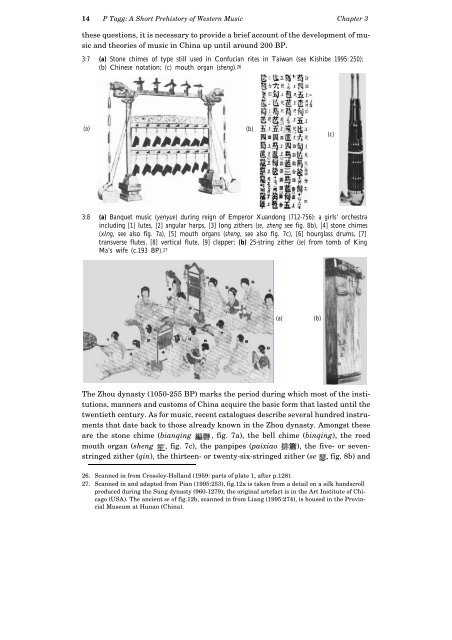A Short Prehistory of Western Music, Chapter 3
A Short Prehistory of Western Music, Chapter 3
A Short Prehistory of Western Music, Chapter 3
You also want an ePaper? Increase the reach of your titles
YUMPU automatically turns print PDFs into web optimized ePapers that Google loves.
14 P Tagg: A <strong>Short</strong> <strong>Prehistory</strong> <strong>of</strong> <strong>Western</strong> <strong>Music</strong> <strong>Chapter</strong> 3<br />
these questions, it is necessary to provide a brief account <strong>of</strong> the development <strong>of</strong> music<br />
and theories <strong>of</strong> music in China up until around 200 BP.<br />
3:7 (a) Stone chimes <strong>of</strong> type still used in Confucian rites in Taiwan (see Kishibe 1995:250);<br />
(b) Chinese notation; (c) mouth organ (sheng). 26<br />
(a) (b)<br />
3:8 (a) Banquet music (yenyue) during reign <strong>of</strong> Emperor Xuandong (712-756): a girls’ orchestra<br />
including [1] lutes, [2] angular harps, [3] long zithers (se, zheng see fig. 8b), [4] stone chimes<br />
(xing, see also fig. 7a), [5] mouth organs (sheng, see also fig. 7c), [6] hourglass drums, [7]<br />
transverse flutes, [8] vertical flute, [9] clapper; (b) 25-string zither (se) from tomb <strong>of</strong> King<br />
Ma’s wife (c.193 BP). 27<br />
The Zhou dynasty (1050-255 BP) marks the period during which most <strong>of</strong> the institutions,<br />
manners and customs <strong>of</strong> China acquire the basic form that lasted until the<br />
twentieth century. As for music, recent catalogues describe several hundred instruments<br />
that date back to those already known in the Zhou dynasty. Amongst these<br />
are the stone chime (bianqing , fig. 7a), the bell chime (binqing), the reed<br />
mouth organ (sheng , fig. 7c), the panpipes (paixiao ), the five- or sevenstringed<br />
zither (qin), the thirteen- or twenty-six-stringed zither (se , fig. 8b) and<br />
26. Scanned in from Crossley-Holland (1959: parts <strong>of</strong> plate 1, after p.128).<br />
27. Scanned in and adapted from Pian (1995:253), fig.12a is taken from a detail on a silk handscroll<br />
produced during the Sung dynasty (960-1279); the original artefact is in the Art Institute <strong>of</strong> Chicago<br />
(USA). The ancient se <strong>of</strong> fig.12b, scanned in from Liang (1995:274), is housed in the Provincial<br />
Museum at Hunan (China).<br />
(a)<br />
(b)<br />
(c)














